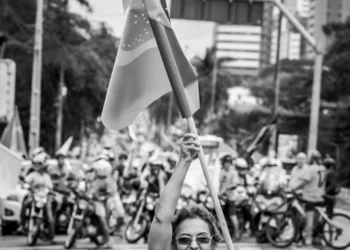by Bartira S. Fortes*, Juliana Porsani, Marcia Camargo, Tamikuã Pataxó, Erilsa Braz Dos Santos, and Iãkupa Apurinã
Reviewed by Matheus Lucas Hebling
In the heart of Brasília, the capital of Brazil, the III Indigenous Women’s March took place from 11 to 13 September 2023. Organized by The National Articulation of Ancestral Warriors Women (ANMIGA) and the Biome Women of Brazil, the III March was centered around the theme “Ecosystem Women in Defense of Biodiversity through Ancestral Roots” (in Portuguese, “Mulheres Biomas em Defesa da Biodiversidade pelas Raízes Ancestrais”), setting the stage for vital discussions and advocacy for Indigenous rights (ANMIGA, 2023a). Women representing each of Brazil’s six biomes gathered to address local and global challenges, engage in political dialogues, and assert the fundamental role of Indigenous women in preserving biodiversity. Throughout an intensive three-day program, encompassing plenary sessions, debates, and working groups, the march addressed pressing environmental issues and gender-based inequalities, spanning critical areas such as responses to climate emergencies and the combating of violence against Indigenous women. In this article, I explore my observations during the III March, with a particular focus on the maracá. This sacred instrument emerged as a powerful symbol of unity, ancestral heritage, and resistance, as Sonia Guajajara eloquently conveyed in the Chamber of Deputies during a Special Session dedicated to the III March.
Today, we stand here, although the journey was arduous. We encountered numerous challenges, but we have entered these spaces with unwavering strength. We are deeply interconnected and work with remarkable coordination, striving to instigate societal and institutional changes. We aim to show the diversity of Indigenous women, and this is what Brazil must grasp and embrace: the inclusion of our maracás in the public sphere and positions of power! (@guajajarasonia, 2023, author’s translation)
During this session, over 500 Indigenous women actively participated in another historic moment when Congresswoman Célia Xakriabá submitted a Bill to Combat Violence Against Indigenous Women (Projeto de Lei PL 4381/2023). The maracá, serving as a powerful tool to amplify the voices of Indigenous women, played a pivotal role in these developments as its resonating sounds filled the entire building. This monumental event had a dual purpose: to empower Indigenous women in politics and ensure their active participation in decision-making processes and influential roles, and to instigate essential dialogues for the formulation of public policies that address the specific needs of Indigenous people.
Indigenous women have already achieved notable strides in politics, with 17 candidacies for federal and state deputy positions supported in 2022 through the formation of the “Bancada do Cocar” (Feathered Headdress Lobby) – a symbolic reference to Indigenous headdress. The victories of Sonia Guajajara and Célia Xakriabá, representing Indigenous women in the Ministry of Indigenous Peoples and the Chamber of Deputies, marked these achievements. Moreover, the III March took place under a changed political landscape, with Luiz Inácio Lula da Silva as Brazil’s President, enjoying significant support from Indigenous people. In his inaugural address, President Lula framed Brazil’s environmental commitments and Indigenous rights as the foundation for the country’s global standing and the restoration of democratic ideals (Planalto, 2023). However, the struggle to confront the enduring consequences of centuries of colonization is far from over, and the III March has demonstrated the leading role of Indigenous women in this battle.
On September 13, beneath the radiant, sunlit skies and accompanied by the enchanting melodies of maracá and sacred songs, a resounding symphony emerged. Approximately 8,000 Indigenous women, encompassing the six Brazilian biomes and international Indigenous groups, gathered in Brasília to march together from the National Arts Foundation (Funarte) to the Bandeiras’ Square (Praça das Bandeiras). The maracá served as a vibrational force that resonated along with the footsteps of thousands of women. As they marched, the melodious and rhythmic sounds of the maracá synchronized their steps, underscoring their shared commitment to Indigenous resistance, environmental protection, and gender equality. The march stood as a testament to Indigenous women’s unity, empowerment, and resilience. These women were not just participants but assertive agents of change, raising their voices in harmony with the rhythmic beat of the maracá to demand Indigenous rights. Their resounding message was a firm “No” to the Temporal Milestone (Marco Temporal), decisively opposing legislative proposals that limit and threaten Indigenous territorial rights. Top of Form
The Temporal Milestone proposal asserts that Indigenous peoples can only have their land demarcated if they can provide evidence of their physical presence on the land on the precise date of the Constitution’s promulgation on October 5, 1988 (Lisbois & Silva, 2012; Leal de Oliveira, Ruy Bragatto, Montenegro de Souza Lima, 2023). This requirement imposes the challenging burden of proof on Indigenous communities, one that is oftentimes impossible to meet. Many instances exist where Indigenous people were dispossessed of their lands both before and after the Constitution’s promulgation, due to violent conflicts and historical injustices. However, land demarcation stands as a cornerstone for Indigenous people, offering essential legal recognition and safeguarding of their ancestral land. Its significance surpasses mere land rights, as it’s intricately linked to their cultural rights and the protection of the environment with its diverse ecosystems.
To combat the deeply entrenched consequences of colonization, which include structural and intersectional marginalization and oppression, and pave the way for Indigenous women’s participation in political spheres, a profound and transformative shift in epistemic-ontological perspectives is essential (Bartira, Porsani & Lalander, 2023). This realization is in line with Sonia Guajajara’s imperative for “reforesting minds” (Guajajara, 2022), and Célia Xakriabá’s claim to “womanize” politics (Mondardo & Nascimento, 2023, p. 5). These combined views highlight the necessity of sowing the seeds of Indigenous knowledge, reestablishing connections with ancestral roots, and revitalizing the cultural and spiritual heritage that has sustained Indigenous people for generations. This shift is echoed in the appointment of Indigenous women to positions of power, signifying a departure toward decolonial political alternatives.

During the III March, the discussions extended beyond the challenges faced by Indigenous people. Empowered women from diverse backgrounds came together to discuss solutions to commonly experienced problems by sharing experiences, strategies, and innovative approaches. Their concerns and demands were also voiced in the III March’s final document (ANMIGA, 2023b). They emphasized the vital importance of reforesting minds with ancestral values and connecting with their roots. Accordingly, these Indigenous women advocated for the inseparable link between biodiversity and land demarcation, stressing that without protected lands, basic rights such as education, culture, and health are jeopardized. They highlighted the urgent need to address climate change and gender-based violence about the well-being of future generations through improved health services and education. Additionally, international and national panels addressed issues related to water rights and ancestral traditions, and Indigenous women explored ways to strengthen their political engagement, including their participation and support in future elections. Finally, an informal tribunal shed light on various ongoing violations against Indigenous communities, stressing the government’s responsibility to uphold its constitutional obligations. In it, Indigenous women denounced a range of abuses against their body territories – such as labor exploitation, infringements by mining and agribusiness interests, and various acts of violence against women including sexual assault.
As an active participant in this historic event, I was deeply touched by the immense articulation and potential for transformation through collective action, especially within the context of Indigenous women’s pursuit of their rightful place in society. My experience was a profound emotional journey as I stood amongst this assembly of empowered Indigenous women. Their harmonious and powerful singing, combined with the rhythmic cadence of their songs, infused with the unique soundscapes of each ethnic group, evoked a deep emotional response that resonated within my body. It bestowed upon me a profound sense of unity and shared purpose. The body paintings that adorned these women’s skin, serving as sacred protection, offered a vivid narrative of resilience. Each brushstroke of vibrant urucum and jenipapo pigments provided me with a poignant glimpse into their stories. The maracá, extending beyond its role as a percussion instrument, reverberated as a shared emblem of the enduring strength and ancestral heritage embodied by these ancestral female warriors.
The III Indigenous Women’s March, with the maracá as its unifying force, elevated the voices of Indigenous women to unprecedented levels. It conveyed the urgency of fundamental shifts in epistemic-ontological paradigms, and consequentially of social, cultural, political, and economic changes to concretize Indigenous women’s relentless claim for land demarcation, environmental protection, and gender equality. In the ongoing pursuit of these goals, the maracá emerges as an emblem of unity, resistance, and hope, underscoring the vital importance of Indigenous heritage, the power of collective mobilization, and the leading role of Indigenous women, empowered by sacred instruments, in paving the future into more socially and environmentally just ancestral directions.
References
@guajajarasonia. “Na tarde desta segunda-feira (11), a Câmara dos Deputados realizou uma Sessão Solene em homenagem a III Marcha das Mulheres Indígenas”. Instagram, September 12, 2023, https://www.instagram.com/p/CxEcRU8PAK0/?utm_source=ig_web_copy_link&igshid=MzRlODBiNWFlZA==
Anmiga, 2023a. “For an end to violence against indigenous women, the III Indigenous Women’s March will take to the streets of Brasilia on Wednesday (13/09)”. Anmiga, September 13, 2023, https://anmiga.org/en/for-an-end-to-violence-against-indigenous-women-the-iii-indigenous-womens-march-will-take-to-the-streets-of-brasilia-on-wednesday-13-09/
Anmiga, 2023b. “Documento final”. https://cimi.org.br/wp-content/uploads/2023/09/Documento-Final-III-Marcha-das-Mulheres.pdf
Fortes, B. S., Porsani, J., & Lalander, R. Contesting Extractivism through Amazonian Indigenous Artivism: Decolonial reflections on possibilities for crafting a pluriverse from within. Alternautas, 10.1 (2023): 155-190, 2023. DOI: 10.31273/an.v10i1.1300
Planalto. “Discurso do presidente Lula no Parlatório do Palácio do Planalto”. Planalto, 6 January 2023, https://www.gov.br/planalto/pt-br/acompanhe-o-planalto/discursos-e-pronunciamentos/2023/discurso-do-presidente-lula-no-parlatorio-do-palacio-do-planalto.
Guajajara, S. “It’s Time to Indigenize Politics and Reforest Minds”, Sumaúma, September 27, 2022, https://sumauma.com/en/aldear-a-politica-e-reflorestar-mentes/
LEAL DE OLIVEIRA, A., RUY BRAGATTO, J., & MONTENEGRO DE SOUZA LIMA, M. A Inconstitucionalidade do Marco Temporal: Riscos e Ameaças à Tutela dos Povos Indígenas do Brasil. Revista Direitos Sociais E Políticas Públicas, 10.3 (2023): 455-486. DOI: 10.25245/rdspp.v10i3.1349
LIBOIS, R. D., & SILVA, R. J. da. Marco temporal, Supremo Tribunal Federal e Direitos dos Povos Indígenas: Um Retrocesso Anunciado. PerCursos, 22.48 (2021): 399-429. DOI: 10.5965/1984724622482021399.
MONDARDO, M., DO NASCIMENTO, Z. “Povos indígenas, comunidades quilombolas e migrações”. Revista Tocantinense de Geografia, 12.26 (2023): 01–21. DOI: 10.20873/rtg.v12i26.15747.
* Bartira S. Fortes is a Brazilian performance artist, anthropologist, and Ph.D. candidate in Environmental studies at the Department of Environment, Development, and Sustainability Studies, Södertörn University, Sweden. She investigates Indigenous ethnomedia in Latin America, focusing on how Indigenous people have used media technologies as a tool for mobilization. Her academic background can be found in the conjuncture of Humanities and Social Sciences, intersecting environmental science, global development studies, social anthropology, performing arts, and media. Her research interests include themes of democracy, climate change, Indigenous media and art, Indigenous people’s participation in global politics, socioenvironmental justice, digital activism, artivism, and decolonization.
Apurinã, Bartira Fortes, Marcia Camargo, Juliana Porsani, Tamikuã Pataxó, Erilsa Braz Dos Santos and Iãkupa. 2023. "Maracá in Resistance: Amplifying the Voices of Indigenous Women in the III Indigenous Women’s March". Brazilian Research and Studies Blog. ISSN 2701-4924. Vol. 4 Num. 3. Available at: https://www.bras-center.com/maraca-in-resistance-amplifying-the-voices-of-indigenous-women-in-the-iii-indigenous-womens-march/, accessed on: July 8, 2025.








